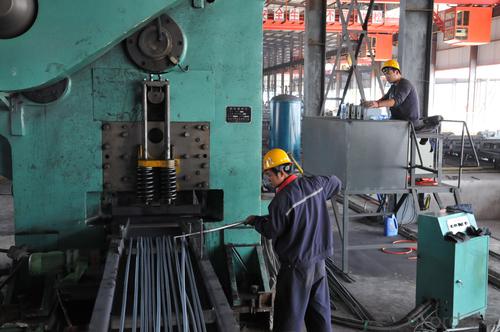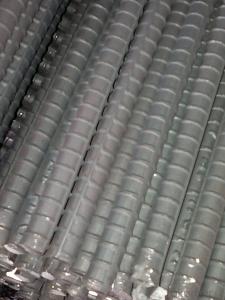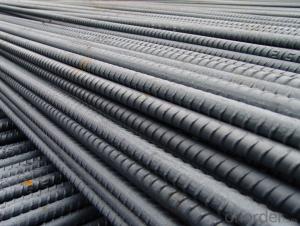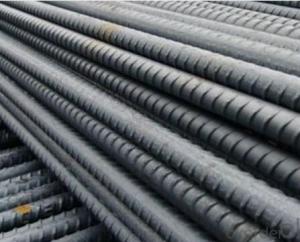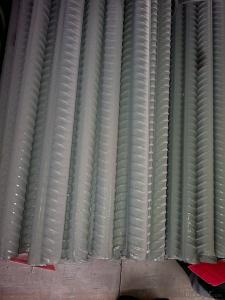Reinforcing Steel Bar for Concrete
- Loading Port:
- China Main Port
- Payment Terms:
- TT or LC
- Min Order Qty:
- -
- Supply Capability:
- -
OKorder Service Pledge
OKorder Financial Service
You Might Also Like
Product Description:
OKorder is offering Reinforcing Steel Bar for Concrete at great prices with worldwide shipping. Our supplier is a world-class manufacturer of steel, with our products utilized the world over. OKorder annually supplies products to African, South American and Asian markets. We provide quotations within 24 hours of receiving an inquiry and guarantee competitive prices.
Product Applications:
Reinforcing Steel Bar for Concrete are ideal for structural applications and are widely used in the construction of buildings and bridges, and the manufacturing, petrochemical, and transportation industries.
Product Advantages:
OKorder's Reinforcing Steel Bar for Concrete are durable, strong, and wide variety of sizes.
Main Product Features:
· Premium quality
· Prompt delivery & seaworthy packing (30 days after receiving deposit)
· Can be recycled and reused
· Mill test certification
· Professional Service
· Competitive pricing
Product Specifications:
Manufacture: Hot rolled
Grade: HRB335
Size: 6mm-25mm
Certificates: ISO, SGS, BV, CIQ
Length: 6m – 12m, as per customer request
Packaging: Export packing, nude packing, bundled
| DEFORMED BAR | |
| SIZE d(mm) | theoretical kg/m |
| 6 | 0.222 |
| 8 | 0.395 |
| 10 | 0.617 |
| 12 | 0.888 |
| 14 | 1.21 |
| 16 | 1.58 |
| 18 | 2 |
| 20 | 2.47 |
| 22 | 2.98 |
| 25 | 3.85 |
| 28 | 4.83 |
| 32 | 6.31 |
Grade | Technical data of the original chemical composition (%) | |||||||
C | Mn | Si | S | P | B | |||
HRB335 | ≤0.25 | ≤1.60 | ≤0.80 | ≤0.045 | ≤0.045 | >0.0008 | ||
Physics capability | ||||||||
Yield Strength(N/cm2) | Tensile Strength(N/cm2) | Elongation (%) | ||||||
≥335 | ≥490 | ≥16 | ||||||
Grade | Technical data of the original chemical composition (%) | |||||||
C | Mn | Si | S | P | V | |||
HRB400 | ≤0.25 | ≤1.60 | ≤0.80 | ≤0.045 | ≤0.045 | 0.04-0.12 | ||
Physics capability | ||||||||
Yield Strength(N/cm2) | Tensile Strength(N/cm2) | Elongation (%) | ||||||
≥400 | ≥570 | ≥14 | ||||||
FAQ:
Q1: Why buy Materials & Equipment from OKorder.com?
A1: All products offered byOKorder.com are carefully selected from China's most reliable manufacturing enterprises. Through its ISO certifications, OKorder.com adheres to the highest standards and a commitment to supply chain safety and customer satisfaction.
Q2: How do we guarantee the quality of our products?
A2: We have established an advanced quality management system which conducts strict quality tests at every step, from raw materials to the final product. At the same time, we provide extensive follow-up service assurances as required.
Q3: How soon can we receive the product after purchase?
A3: Within three days of placing an order, we will arrange production. The normal sizes with the normal grade can be produced within one month. The specific shipping date is dependent upon international and government factors, the delivery to international main port about 45-60days.
Images:
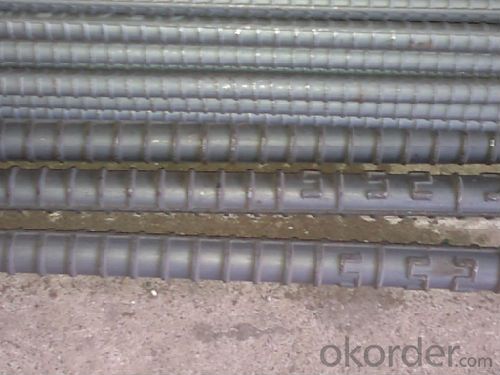
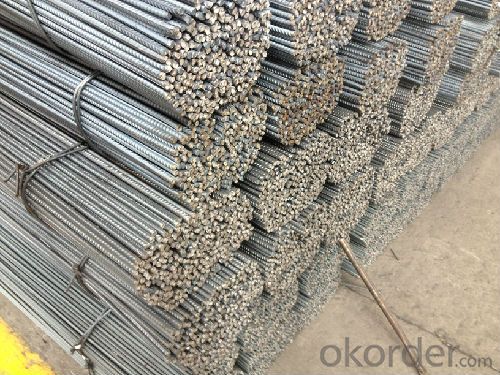
- Q: Are there any safety concerns related to handling steel rebars?
- Handling steel rebars comes with safety concerns. Not only are steel rebars heavy, but they can also strain muscles if not lifted correctly. To avoid injury, it is important to use appropriate lifting techniques and equipment, including gloves, back supports, and lifting tools. Furthermore, the sharp edges of rebars can puncture or lacerate, making it vital to wear protective clothing like steel-toed boots and gloves. Tripping hazards are also a concern when rebars are scattered on the ground. Keeping the work area clear and practicing good housekeeping can mitigate accidents. Lastly, power tools like cutting saws are commonly used when working with rebars. These tools generate noise, dust, and debris, so it is essential to wear protective gear such as hearing protection, dust masks, and eye protection. In conclusion, adhering to safety guidelines and proper procedures is imperative when handling steel rebars to prevent accidents and injuries.
- Q: Can steel rebars be used in road and bridge construction?
- Yes, steel rebars can be used in road and bridge construction. Steel rebars are commonly used as reinforcement in concrete structures, including roads and bridges, to provide strength and durability. The rebars are embedded within the concrete to enhance its tensile strength and prevent cracking or structural failure. Steel rebars are preferred in such constructions due to their high strength, ductility, and resistance to corrosion. They help to distribute loads and stresses evenly, making the structures more resilient and capable of withstanding heavy traffic and environmental conditions. Additionally, steel rebars can be easily fabricated and customized to meet the specific design requirements of road and bridge construction projects.
- Q: Can steel rebars be used in structures with high resistance to earthquakes?
- Yes, steel rebars can be used in structures with high resistance to earthquakes. Steel rebars are commonly used in seismic-resistant structures due to their high tensile strength and ductility. They are able to absorb and dissipate the energy generated during an earthquake, providing reinforcement and stability to the structure. Additionally, modern construction techniques and design codes ensure that steel rebars are properly integrated into earthquake-resistant structures to enhance their overall resilience.
- Q: Can steel rebars be recycled after the demolition of a structure?
- Yes, steel rebars can be recycled after the demolition of a structure. Steel is one of the most commonly recycled materials in the world, and rebars are no exception. During the demolition process, rebars are typically removed from the structure and separated from other materials such as concrete. The rebars are then collected and sent to a recycling facility where they are processed and melted down. The melted steel can be used to create new rebars or other steel products, reducing the need for virgin steel production and conserving valuable resources. Recycling rebars not only helps to reduce waste and minimize environmental impact but also contributes to the circular economy by promoting the reuse of materials.
- Q: Are steel rebars suitable for use in high-rise buildings?
- Yes, high-rise buildings can use steel rebars as they are suitable for this purpose. Steel rebars, also known as reinforcing bars, are commonly utilized in the construction industry to provide strength and stability to concrete structures. In order to withstand various loads and forces like wind, earthquakes, and the weight of the building itself, high-rise buildings require a robust and resilient structural system. Steel rebars possess exceptional tensile strength and ductility, making them an ideal choice for reinforcing concrete in such structures. One of the primary advantages of steel rebars is their ability to resist tensile forces. While concrete is strong in compression, it is weak in tension. Steel rebars help overcome this weakness by providing the necessary tensile strength. This is particularly important in high-rise buildings where the weight of the structure can induce tension on the concrete components. By reinforcing the concrete with steel rebars, the overall structural integrity of the building is enhanced, ensuring its safety and stability. Furthermore, steel rebars exhibit superior ductility, meaning they can deform under stress without fracturing. This property is crucial in high-rise buildings as they are subjected to dynamic loads and potential movements caused by factors like wind or seismic activity. Steel rebars can absorb and distribute these forces, minimizing the risk of structural failure or collapse. Moreover, steel rebars are readily available and cost-effective compared to alternative materials such as carbon fiber or fiberglass. They can be easily fabricated and installed in various shapes and sizes to meet the specific design requirements of high-rise buildings. However, it is important to note that the suitability of steel rebars in high-rise buildings also relies on proper design, installation, and regular maintenance. It is crucial to adhere to the relevant building codes and standards, ensure adequate corrosion protection, and conduct regular inspections to identify any potential issues. By following these practices, steel rebars can provide a dependable and long-lasting reinforcement solution for high-rise buildings.
- Q: Can steel rebars be used in the construction of sports stadiums?
- Yes, steel rebars can be used in the construction of sports stadiums. Steel rebars are commonly used in reinforced concrete structures, including stadiums, as they provide strength and durability to the overall structure. The use of steel rebars helps to reinforce the concrete and ensure the stadium's structural integrity, making it a suitable choice for construction in sports stadiums.
- Q: Are steel rebars resistant to termites and other pests?
- No, steel rebars are not resistant to termites and other pests.
- Q: What are the common sizes of steel rebars used in construction?
- The sizes of steel rebars used in construction can vary depending on the specific application and engineering requirements. However, there are several standard sizes that are widely used in the industry. The industry commonly utilizes rebar sizes ranging from #3 to #18. These numbers represent the diameter of the rebar in eighths of an inch. For instance, a #3 rebar has a diameter of 3/8 inch, while a #18 rebar has a diameter of 2 1/4 inches. Regarding metric measurements, the most frequently used rebar sizes range from 10mm to 40mm in diameter. These sizes are typically designated by their nominal diameter in millimeters, such as 10mm, 12mm, 16mm, 20mm, 25mm, 32mm, and 40mm. The selection of the appropriate rebar size depends on various factors, including the required load-bearing capacity, the structural design, and the type of construction project. Smaller diameter rebars, like #3 or 10mm, are typically utilized in lighter construction projects or for smaller concrete elements like walls or slabs. Conversely, larger diameter rebars, like #18 or 40mm, are commonly employed in heavy-duty applications such as bridges, high-rise buildings, or large-scale infrastructure projects. It is important to note that different countries or regions may have their own specific standards regarding rebar sizes. Consequently, it is crucial to consult local building codes and regulations to ensure compliance.
- Q: How do steel rebars affect the overall cost of maintenance in a structure?
- Steel rebars can have a significant impact on the overall cost of maintenance in a structure. The use of steel rebars enhances the structural integrity and durability of the building, reducing the risk of structural failures and minimizing maintenance requirements. Steel rebars help to reinforce the concrete, making the structure more resistant to cracks, corrosion, and other forms of damage. By preventing or delaying these issues, the overall cost of maintenance, repairs, and replacements is reduced over the lifespan of the structure.
- Q: Can steel rebars be used in dam construction?
- Yes, steel rebars can be used in dam construction. They are commonly used to reinforce concrete structures, including dams, to enhance their strength and durability.
Send your message to us
Reinforcing Steel Bar for Concrete
- Loading Port:
- China Main Port
- Payment Terms:
- TT or LC
- Min Order Qty:
- -
- Supply Capability:
- -
OKorder Service Pledge
OKorder Financial Service
Similar products
Hot products
Hot Searches
Related keywords



